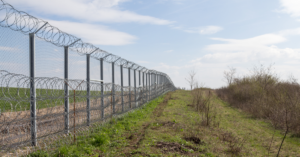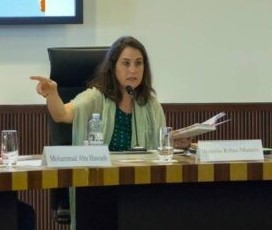This blog follows the launch of the new book: Handbook on Human Security, Borders and Migration.
Follow this link for additional promotional material for the book – passcode: &J04F*Gd
Drawing on the concept of the “politics of compassion”, the Handbook on Human Security, Borders and Migration interrogates the political, geopolitical, social and anthropological processes which produce and govern borders and which give rise to contemporary border violence.

Border fence between Serbia and Hungary constructed in 2015. © Shutterstock BalkansCat
What you will find throughout the book
Offering empirical analyses of critical border regions and zones, the examples of the book cover the US-Mexico border region, border zones around the Mediterranean and borders in South America, Eastern Europe, Central Africa, the Middle East and the UK-Ireland division. The book provides a truly transnational approach to borders and migration, demonstrating the dynamic, asymmetric relationship between the social structure of border enforcement and the human agency of migrants and activists.
Thus, our focus is on people, migrants and those working helping find their ability to navigate social structures designed to subordinate them, and the broader human rights consequences of these efforts. We examine this in light of “the politics of compassion,” which is critical of the typical hierarchical relationship between the helper and the helped and instead looks for what elevates human dignity. Thus, our focus is on the clash between the human security of migrants (human rights) and state power in border regions (national sovereignty) and the many ways this plays out in a remarkable array of case studies from around the world.
The book is exceptional in shifting focus to a host of less examined, very rich case studies, as seen through the broader lens of human security. These include the political economy and repression of violent expulsions in Myanmar, Amazonian borders of Brazil, Burundi, the Central African Republic, as well as the migration of African women to Europe, and the experiences of migrant children in Iran as well as in the Western Mediterranean. In addition, the project cases examine the formation and fluid shifts in the enforcement of borders of Macau-Hong Kong, Crimea (Ukraine-Russia), and Ireland-Northern Ireland and their impact on people. Across the uniquely wide range of case studies in this project we see the extraordinary perseverance and creativity of migrants, activists, and residents in border regions to assert their humanity in the face of daunting human insecurity imposed and exacerbated by state border enforcement structures. We see the deeply human face of migration confronting state (and indirectly, corporate and financial) power in a plethora of contemporary border regions and migrations.
Pointing out Key Paradoxes
The contribution of the book suggests opening at least four different paradoxes which bind several of these chapters together.
The Paradox of Contemporary Mobility Itself
Mobilities are easier and simultaneously harder with emerging nationalism, populism and pandemic measures. In general, according to mobility filters (using long-running ethic and racial profiling), it gets particularly harder for asylum seekers, lower-class migrants and populations from the Global South.
The Paradox of Humanity and the Humanitarian
Human rights are also additionally precarious at the borders of a State, as this tends to be a space where the State sovereignty and security needs tend to trump civilian and individual rights and liberties – though many of the security concerns in the case of borders between rich and poor nations. Humanitarian relief efforts and refugee-support services are also usually based at a border, and these create an entirely different form of cross-border networking and flow of people and goods. Within it, how does civil society organize complex responses? How does the State violate the right of migrants in the midst of pervasive border control and walls construction?
Is violence the paradigmatic concept in this second paradox? Such proliferation of expulsions and violence makes us go beyond the mere description of border violence. However, the real research task is to identify predatory formations which are dressed in pretty robes.
Secondly, there is compassion. As some analysts argue, compassion is crucial for democratic politics and essential to humanitarian assistance, others are more skeptical, pointing out that compassion has a tendency to be fitful and often fails to deliver on its promises. Thus, compassion is necessary, but is not sufficient by itself.
Thirdly, the concept to consider is necropolitics. Mourning and death, death in the Mediterranean and horrorism… Necropolitics crosses many chapters of the project, by referring to the sovereign right to kill.
The Paradox of Border Control and Border Policies
The first element here is security. Trafficking, militarization, enforcement, technological security, policing, spatial incarceration, confinement, securitization, many names that imply that migrants are invaders and human mobility is an aberration. Overall, the chapters in this volume emphasize just the opposite through the analysis of the diversity of origins, consequences and experiences of varied patterns of human mobility. Through militarization we have the example of the paradigmatic US–Mexico region, put into practice by border law enforcement agencies using all kinds of military equipment, troops, aerial reconnaissance/surveillance.
The Paradox of Inequality
Described inequality in border realities is linked with the discontinuity of geopolitical borders and the porous state: some borders are still weak, others experience a sudden intensified control, others continue the emergence of strict control since the implications of the policies on the “war on terror”. How do such contemporary inequalities provoke numerous differentiated forms related to the “encampment of the world”, the increase of expulsion, the proliferation of new transitory spaces? What is the impact of such inequalities? Inequalities palpable through human costs of current deportation regimes like in the cases of Guatemala, el Salvador, Cameroon, Central African Republic are the clearest expressions to the punishment to mobility.
What are the answers to them? Probably through global responsibilities which have to be undertaken considering the changes in “migrations and borders” after the “revolution” of globalized economic neoliberalism. From compassion to culpability, the case for a globalized politics of responsibility like in the case of Burundi-Tanzania border are shown in detail. There are ways to be found that are far from damaging through human aims, ways that are more equitable and economically sustainable, pathways to global peace and justice. The book covers extensively the US–Mexico border region and border zones around the Mediterranean. Border issues in South and Central America, Eastern Europe, Northern Europe, the Middle East, Central Africa and South Eastern Asia are also discussed.

Natalia Ribas-Mateos is an Associated Researcher at the Universitat Autònoma de Barcelona (TRANSMENA Project) and (MESOPOLHIS UMR 7064) Aix-Marseille Université. She has taught in different Spanish and foreign universities and was twice a Marie Curie Fellow (UK-US and France) and also a Ramon y Cajal Fellow in Spain.
Are you currently involved with regional research, policy, and development? The Regional Studies Association is accepting articles for their online blog. For more information, contact the Blog Editor at rsablog@regionalstudies.org.